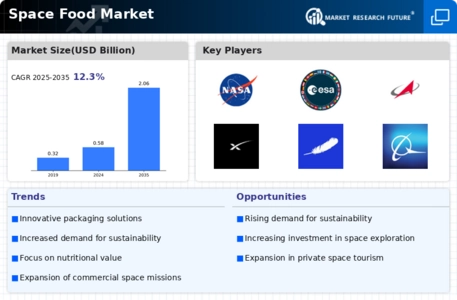Top Industry Leaders in the Space Food Market
 The space food market, a niche yet crucial segment of the space industry, has experienced noteworthy developments and transformations. Understanding the competitive dynamics within this specialized market necessitates an examination of key players, their strategies, market share determinants, the emergence of new entrants, industry updates, investment trends, the overall competitive scenario, and recent developments, especially those occurring in the year 2023.
The space food market, a niche yet crucial segment of the space industry, has experienced noteworthy developments and transformations. Understanding the competitive dynamics within this specialized market necessitates an examination of key players, their strategies, market share determinants, the emergence of new entrants, industry updates, investment trends, the overall competitive scenario, and recent developments, especially those occurring in the year 2023.
List of Key Players
- NASA
- European Space Agency
- Roscosmos
- SpaceX
- Blue Origin
- Boeing
- Lockheed Martin
- Northrop Grumman Corporation
- Orbital ATK
- ISSpresso
- BeeHex
- NanoRacks
- JAXA
- AEB
Strategies Adopted
Key players in the space food market are strategically focusing on research and development endeavors aimed at creating nutritionally balanced, durable, and palatable food options suitable for space travel. NASA, for example, has consistently worked towards enhancing the nutritional content and shelf life of space food. Concurrently, private companies are exploring collaborations with space agencies to develop proprietary food products tailored to the unique requirements of space missions.
Factors for Market Share Analysis
Market share dynamics in the space food industry hinge on several factors, including technological innovation, product quality, partnerships with space agencies, and cost-effectiveness. Companies capable of developing food products that can withstand the challenges of space travel, including microgravity conditions and limited storage capacities, are positioned to secure a larger market share.
New and Emerging Companies
The space food market has witnessed the entry of new and emerging companies, particularly with the rise of private spaceflight entities such as SpaceX and Blue Origin. These newcomers are leveraging innovative food technologies, including 3D food printing and advanced preservation methods, to create more efficient and sustainable solutions for space food. Their presence adds dynamism to an industry traditionally dominated by government-sponsored initiatives.
Industry News and Current Company Updates
Recent industry news underscores the collaboration between space agencies and private companies. Companies are actively working alongside NASA to develop plant-growing systems designed for use in space, potentially revolutionizing space food by enabling the cultivation of fresh produce within space stations or spacecraft. These initiatives reflect the industry's commitment to evolving food production methods for long-term space exploration.
Investment Trends
Investments in the space food sector are witnessing an uptrend, fueled by the increasing interest in space tourism and prolonged space missions. Investors are displaying a keen interest in innovative food technologies that enhance the efficiency and sustainability of space food. This includes investments in closed-loop life support systems, integral to the recycling and regeneration of resources, including food, in space environments.
Overall Competitive Scenario
The overall competitive scenario in the space food market is unique due to the highly specialized nature of the sector. Collaboration between government space agencies and private companies is a defining feature. Competition is less about price and more about technological innovation and the ability to meet the stringent requirements of space food, ensuring it remains safe, nutritious, and palatable in extraterrestrial environments.
Recent Developments
Several significant developments marked the landscape of the space food market. A prominent trend was the heightened focus on sustainability and self-sufficiency in space nutrition, spurred by plans for extended space missions, including potential journeys to Mars. This led to notable advancements in technologies for growing food in space, with experiments in hydroponic and aeroponic systems yielding promising results.
Another key development was the exploration of personalized nutrition in space. Tailoring food to individual astronauts’ dietary needs gained traction as a means to enhance their overall health and performance on prolonged missions. Research into personalized food production systems aimed at creating custom meals to meet the specific nutritional requirements of each astronaut showcased innovation in the industry.
In the realm of packaging solutions, there was a discernible increase in the development of compact and efficient food packaging. These advancements are crucial in the confined spaces of spacecraft, aiming to reduce the volume and weight of food packaging while ensuring the prolonged preservation of food in the challenging conditions of space.
Furthermore, 2023 saw a surge in the commercial space food sector, driven by the growing interest in space tourism. Companies directed efforts towards creating space food products catering not only to nutritional needs but also to the taste preferences and dining experiences of space tourists. This involved the development of gourmet space meals and the adaptation of popular Earth-based foods for consumption in space, aligning with the evolving landscape of commercial space endeavors.


